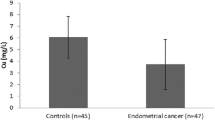Abstract
Serum copper and zinc levels were determined in 20 healthy women and in 100 women with gynecological tumors. Malignant and benign tumor cases were separated according to their postoperative, histopathological examinations. The stages of malignant and benign tumors were also established histologically. Seventy benign and 30 malignant genital tumors (carcinoma of cervix in situ, cervix, ovary endometrium, and vulva) of the patients were differentiated histopathologically.
The serum Cu/Zn ratios of patients were increased significantly from the control group (0.32±0.35) to the benign group (1.22±0.63) and from the benign group to the malignant group (2.24±1.03). Nine of 30 malignant cases were determined as false negative (30%) and 15 of 70 benign cases were determined as false positive (14.2%) according to the serum Cu/Zn ratios of patients. Serum copper levels of 30 malignant and 10 benign tumor cases showed linear correlation with serum ceruloplasmin values.
These results indicate that the serum Cu/Zn ratio may be used as a predictor for the presence of malignant gynecological tumors and its stages.
Similar content being viewed by others
References
M. Hrgovcic, C. F. Tessmer, F. B. Thomas, P. S. Ong, J. F. Gamble, and C. C. Shutlenberg,Cancer 32, 1512 (1973).
F. W. Alexander, H. T. Delves, and H. Laus,Arch. Dis. Child. 47, 670 (1972).
B. E. Walker, J. B. Dowson, J. Kelleher, and M. S. Losowsky,Gut. 14, 943 (1973).
J. M. Brandes, L. Abraham, A. Drugan, O. Zinder, A. Cohen, and J. ItskovitzActa Obstet. Gynecol. Scand. 62, 225 (1983).
A. Birdi, S. Gupta, and S. S. Gambhir,J. of Surgical Oncology 22, 193 (1983).
U. Derman, E. Büyükünal, F. Baykurt, and I. Toy,J. of Cerrahpasa Fac. of Med. 11, 42 (1980).
G. L. Fisher, V. S. Byers, M. Shifrine, and A. S. Levin,Cancer 37, 356 (1976).
W. H. Strain, E. G. Mansour, A. Flynn, W. J. Pories, A. J. Tomaro, and O. A. Hill,Lancet I, (Letter), 1021 (1972).
K. S. Morton,Cancer Research 35, 3481 (1975).
S. Inutsuka and S. Araki,Cancer 42, 626 (1978).
P. Bilaloĝlu, phD Thesis, University of Hacettepe, Faculty of Medicine, Ankara, Turkey (1977).
K. H. Schosinsky, H. P. Lehmann and M. F. Beeler,Clin. Chem. 20, 1556 (1974).
P. Tani and K. Kokkola,Scand J. Respir Dis. (Suppl.)80, 121 (1972).
D. H. Russell,Clin Chem 23, 22 (1977).
R. J. Cousins,Nutr. Rev. 37, 97 (1979).
Author information
Authors and Affiliations
Rights and permissions
About this article
Cite this article
çetinkaya, N., çetinkaya, D. & Yüce, M. Serum copper, zinc levels, and copper. Biol Trace Elem Res 18, 29–38 (1988). https://doi.org/10.1007/BF02917486
Received:
Accepted:
Issue Date:
DOI: https://doi.org/10.1007/BF02917486




